Handbook for Palm™ m100 Series Handhelds
Contents
About This Book
Chapter 1: Introduction to Your Handheld
Getting to know your Palm m100 series handheld
What is a Palm m100 series handheld?
System requirements
Minimum requirements: Windows
Minimum requirements: Macintosh
Optional equipment
Palm m100 series components
Locating front panel controls
Using the backlight
To activate the backlight:
To turn off the backlight:
Locating back panel components
Upgrading from another Palm OS handheld
Preparing to use your handheld
To use your handheld and Palm Desktop software, complete the following:
Using the protective flip cover
To remove the cover:
To reattach the cover:
Changing the face plate
To remove the face plate:
To attach the face plate:
Installing the batteries
To install the batteries:
Palm Desktop software
With Palm Desktop software, you can do the following:
Connecting the HotSync cradle/cable
Installing Palm Desktop software
To install Palm Desktop software on a Windows computer:
To install Palm Desktop software on a Macintosh computer:
Using your handheld with another PIM
Tapping and typing
Tap with the stylus to get things done
Elements of the handheld interface
Opening applications
To open an application on your handheld:
Using menus
To open the menu bar:
Choosing a menu
Graffiti menu commands
Displaying online tips
To display an online tip:
Entering data
Onscreen keyboard
Graffiti writing
To open Memo Pad:
Note Pad
Using Palm Desktop software
Importing data
Using an external keyboard
Customizing your handheld
To open the Preferences screens:
To set the date:
To set the time:
To set the time zone:
To set the daylight saving switch:
Chapter 2: Entering Data in Your Handheld
Using Graffiti writing to enter data
Writing Graffiti characters
There are four basic concepts for success with Graffiti writing:
To write Graffiti letters:
Graffiti tips
The Graffiti alphabet
Writing capital letters
To draw the first letter of a word as a capital letter:
To enter only capital letters (Caps Lock):
Writing numbers
Graffiti numbers
Writing punctuation marks
Additional Graffiti punctuation
Writing symbols and extended characters
Writing accented characters
Accent strokes
Additional non-English characters
Navigation strokes
Graffiti ShortCuts
Using the onscreen keyboard
To use the onscreen keyboard:
Using Note Pad
To use Note Pad:
Using your computer keyboard
Importing data
Importing data from a Windows computer
To import data from a Windows computer:
Importing data from a Macintosh
To import data from a Macintosh:
Chapter 3: Managing Your Applications
Using the Applications Launcher
Selecting applications
Switching between applications
Categorizing applications
To categorize an application:
To display applications by category:
Changing the Applications Launcher display
To change the Applications Launcher display:
To open the Applications Launcher to the last opened category:
Choosing preferences
To change preferences for an application:
Installing and removing applications
Installing add-on applications
To install add-on software on your handheld using a Windows�computer:
To install add-on software on your handheld using a Macintosh:
Removing applications
To remove an add-on application:
Removing Palm Desktop software
To remove Palm Desktop software from a Windows computer:
To remove Palm Desktop software from a Macintosh:
Security
In Security, you can do the following:
Assigning a password
To assign a password:
Changing or deleting a password
To change or delete your password:
Locking your handheld
Locking your handheld automatically
To set your handheld to lock when you turn it off:
To set your handheld to lock at a preset time:
To set your handheld to lock after a period of inactivity:
Locking your handheld manually
To lock and turn off your handheld:
Recovering from a forgotten password
To delete a forgotten password:
Chapter 4: Using Expansion Features
Inserting an expansion card
Removing an expansion card
Opening expansion card applications
To open an application on an expansion card:
Switching between your handheld and an expansion�card
To switch to an expansion card:
Copying applications to an expansion�card
To copy an application to an expansion card:
Deleting applications from an expansion�card
To delete applications from an expansion card:
Card Info
Reviewing card information
Renaming a card
Formatting a card
Card Info menus
Card menus
Chapter 5: Using Your Basic Applications
Overview of basic applications
Date Book
In Date Book, you can do the following:
To open Date Book:
Address Book
In Address Book, you can do the following:
To open Address Book:
To Do List
In To Do List, you can do the following:
To open To Do List:
Note Pad
In Note Pad, you can do the following:
To open Note Pad:
Memo Pad
In Memo Pad, you can do the following:
To open Memo Pad:
Calculator
In Calculator, you can do the following:
To open Calculator:
Clock
In Clock, you can do the following:
To open Clock:
Common tasks
Creating records
To create a record:
Editing records
Entering text
Edit menu
To select text in an application:
Deleting records
To delete a record:
Other ways to delete records
Purging records
To purge records:
Exchanging and updating data: HotSync operations
Performing a HotSync operation for the first time: Windows
To perform a local HotSync operation on a Windows computer:
Performing a HotSync operation for the first time: Macintosh
To perform a local HotSync operation on a Macintosh:
Beaming information
To select a business card:
To beam a record, business card, or category of records:
To beam an application:
To receive beamed information:
Tips on beaming information
Categorizing records
System-defined and user-defined categories
To move a record into a category:
To display a category of records:
To define a new category:
To rename a category:
Finding information
Looking up Address Book records
To look up an Address Book record:
Using Find
To use Find:
Using Phone Lookup
To use Phone Lookup:
Phone Lookup tips
Sorting lists of records
To sort records in To Do List:
To sort records in Address Book, Note Pad, and Memo Pad:
Making records private
Hiding or masking private records
To hide all private records:
To mask all private records:
To display all private records:
To unmask individual records:
To make a record private:
Attaching notes
To attach a note to a record:
To review or edit a note:
To delete a note:
Choosing fonts
To change the font style:
Reviewing Reminders
To respond to reminders, do one of the following:
Application-specific tasks
Date Book
Scheduling an event
To schedule an event for the current day:
To schedule an event for another day:
To schedule an untimed event:
Rescheduling an event
To reschedule an event:
Setting an alarm for an event
To set an alarm for an event:
Scheduling repeating or continuous events
To schedule a repeating or continuous event:
Changing repeating or continuous events
To delete repeating events:
Changing the Date Book view
To cycle through Day, Week, Month, and Agenda views:
To display the current time:
Working in Week View
To display the Week View:
Spotting event conflicts
Working in Month View
Working in Agenda View
To display the Agenda View:
Date Book menus, preferences, and display options
Record menu
Options menu
Address Book
Creating an Address Book entry
To create a new Address Book entry:
Selecting types of phone numbers
To select other types of phone numbers in an entry:
Changing Address Entry details
To open the Address Entry Details dialog box:
Address Book menus
Record menus
Options menus
To Do List
To create a To Do List item:
Setting priority
To set the priority of a To Do List item:
Checking off a To Do List item
To check off a To Do List item:
Changing To Do List item details
To display the To Do Item Details dialog box:
Setting a due date
To set a due date for a To Do List item:
To Do Show Options
To change the Show Options settings:
To Do List menus
Record menu
Options menu
Note Pad
To create a new note:
Reviewing notes
To review a note:
Clearing a note
To clear a note:
Setting an alarm for a note
To set an alarm for a note:
Note Pad menus
Record menus
Options menus
Memo Pad
To create a new memo:
Reviewing memos
To review a memo:
Memo Pad menus
Record menus
Options menus
Calculator
Recent Calculations
To display recent calculations:
Calculator menus
Options menus
Clock
To view the time:
To set an alarm:
Clock menus
Options menu
Chapter 6: Advanced HotSync® Operations
Selecting HotSync setup options
To set the HotSync options on a Windows computer:
To set the HotSync options on a Macintosh:
Customizing HotSync application settings
To customize HotSync application settings on a Windows�computer:
To customize HotSync application settings on a Macintosh:
IR HotSync operations
Preparing your computer for infrared communication
Configuring HotSync Manager for�infrared�communication
To configure HotSync Manager for infrared communication on�a�Windows�computer:
To configure HotSync Manager for infrared communication on�a�Macintosh:
Performing an IR HotSync operation
To perform an IR HotSync operation:
Returning to cradle/cable HotSync operations
To return to local serial cradle/cable HotSync operations on a Windows�computer:
To return to local serial cradle/cable HotSync operations on�a�Macintosh:
Conducting a HotSync operation via modem
Preparing your computer
To prepare your Windows computer for a modem HotSync�operation:
To prepare a Macintosh for a modem HotSync operation:
Preparing your handheld
To prepare your handheld for a modem HotSync operation:
Selecting the conduits for a modem HotSync operation
To change the Conduit Setup for a modem HotSync operation:
Performing a HotSync operation via a modem
To perform a modem HotSync operation:
Using File Link
Creating a user profile
To create a user profile on a Windows computer:
To create a user profile on a Macintosh:
Performing the first HotSync operation with a�user�profile
To use a profile for the first-time HotSync operation on�a�Windows�computer:
To use a profile for the first-time HotSync operation on�a�Macintosh:
Chapter 7: Setting Preferences for Your Handheld
Viewing preferences
To open the Preferences screens:
Buttons preferences
To change the Buttons preferences:
Pen preferences
To change the Pen preferences:
HotSync buttons preferences
To change the HotSync buttons preferences:
Digitizer preferences
Formats preferences
Country default
To set the country default:
Time, date, week start, and numbers formats
To select the time, date, week start, and numbers format:
General preferences
Auto-off delay
To set the Auto-off delay:
System, alarm, and game sounds
To set the system and alarm sounds:
Beam Receive
To change the Beam Receive setting:
Date and Time preferences
Connection preferences
Editing connections
To edit the IR to Phone connection:
Network preferences and TCP/IP software
Selecting a service
To select a service:
Entering a user name
To enter a user name:
Entering a password
To enter a password:
Selecting a connection
To select a connection:
Adding telephone settings
To enter your server phone number:
Entering a prefix
To enter a prefix:
Disabling Call Waiting
To disable Call Waiting:
Using a calling card
To use a calling card:
Connecting to your service
To establish a connection:
To close a connection:
Creating additional service templates
To add a new service template:
To duplicate an existing service template:
Adding detailed information to a service�template
To select a connection type:
Idle timeout
To set the Idle timeout:
Defining primary and secondary DNS
To enter a primary and secondary DNS:
IP address
To identify dynamic IP addressing:
To enter a permanent IP address:
Login scripts
Creating a login script on your handheld
To create a login script:
Plug-in applications
Deleting a service template
To delete a service template:
Network preferences menu commands
Service menu
Options menu
TCP/IP troubleshooting
Displaying expanded Service Connection Progress messages
Viewing the Network Log
To view the Network Log:
Adding a DNS number
Owner preferences
To enter the Owner preferences:
To unlock the Owner Preferences screen:
ShortCuts preferences
Creating a ShortCut
To create a ShortCut:
Editing a ShortCut
To edit a ShortCut:
Deleting a ShortCut
To delete a ShortCut:
Appendix A: Maintaining Your Handheld
Caring for your handheld
Battery considerations
Resetting your handheld
Performing a soft reset
To perform a soft reset:
Performing a hard reset
To perform a hard reset:
To restore your data from a Windows computer after�a�hard�reset:
To restore your data from a Macintosh after a hard reset:
Appendix B: Frequently Asked Questions
Software installation problems
Operating problems
Tapping and writing problems
Application problems
HotSync problems
Beaming problems
Password problems
Technical support
To find version and memory information:
Appendix C: Non-ASCII Characters for Login Scripts
Use of ^char
Carriage return and line feed
Literal characters
Examples:
Product Regulatory Information
Varning
Advarsel!
Varoitus
Advarsel
Waarschuwing!
Uwaga
Index

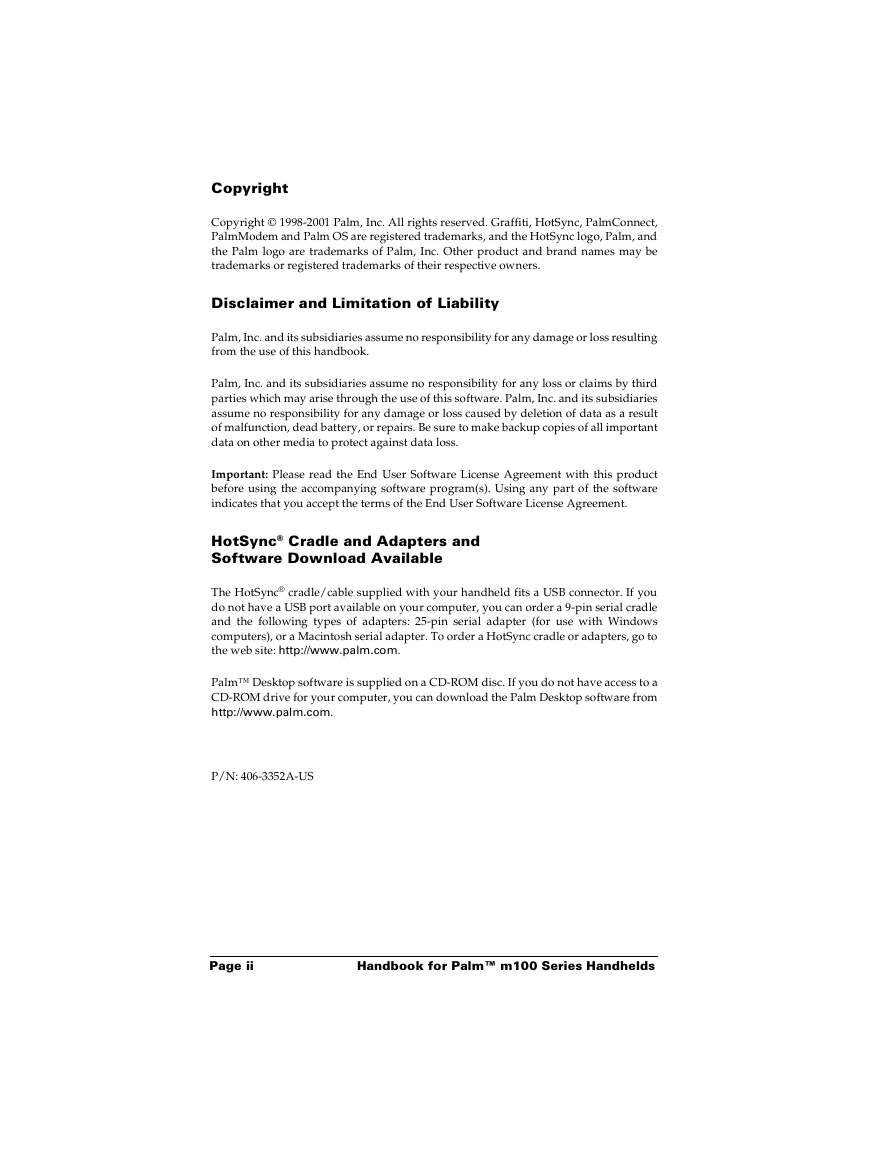
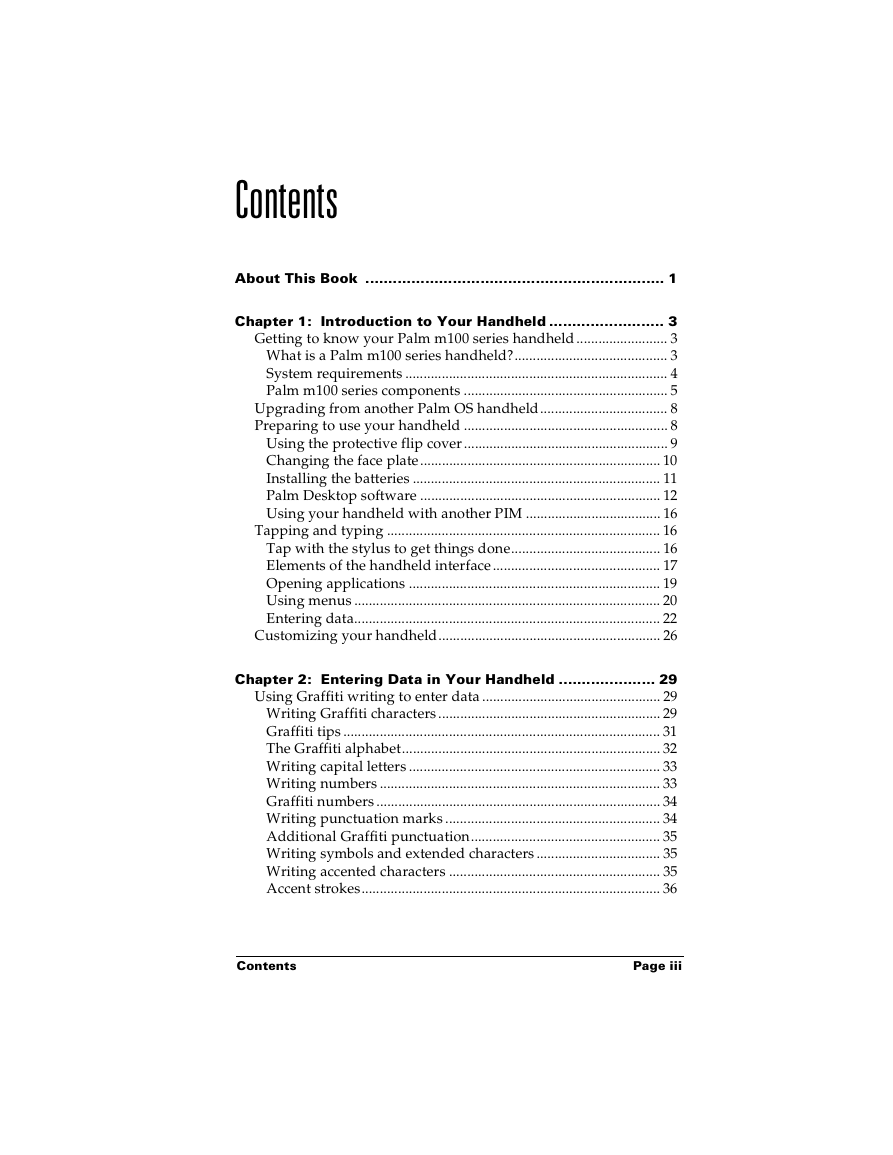
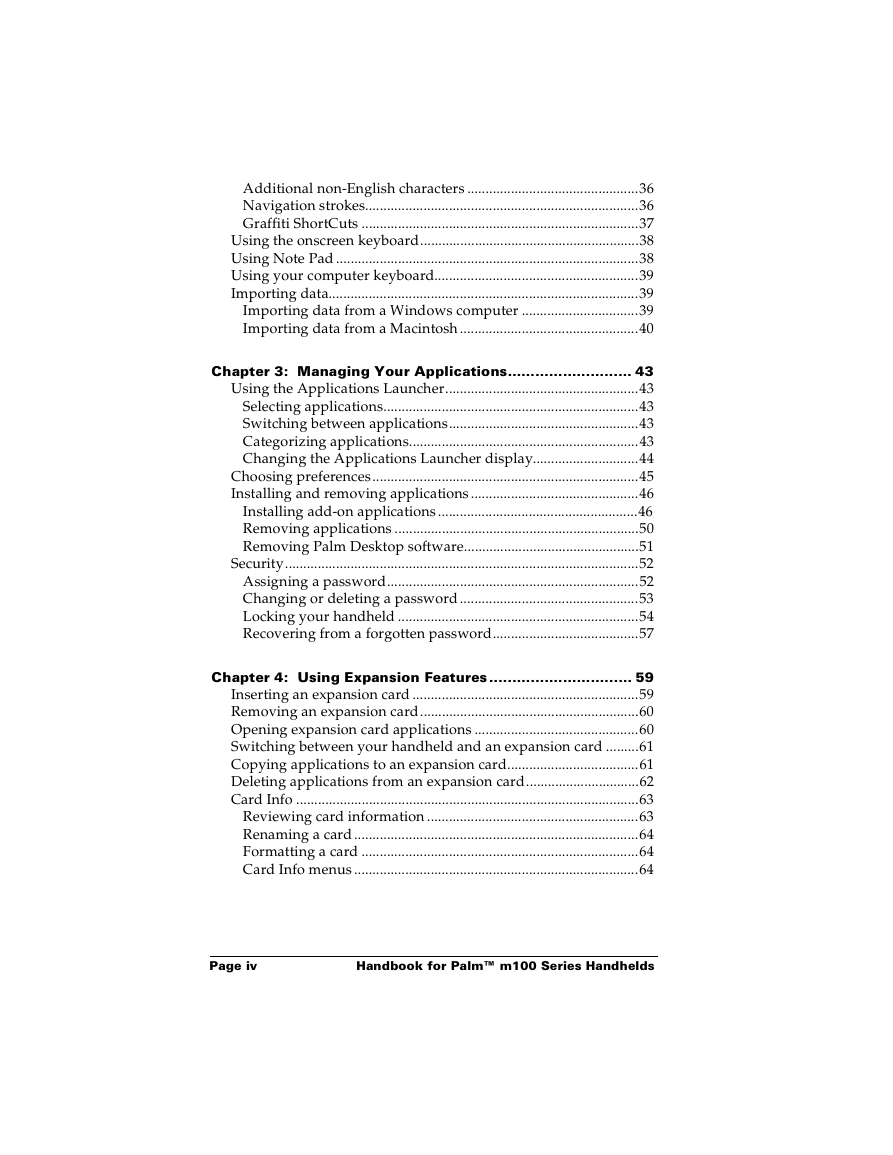
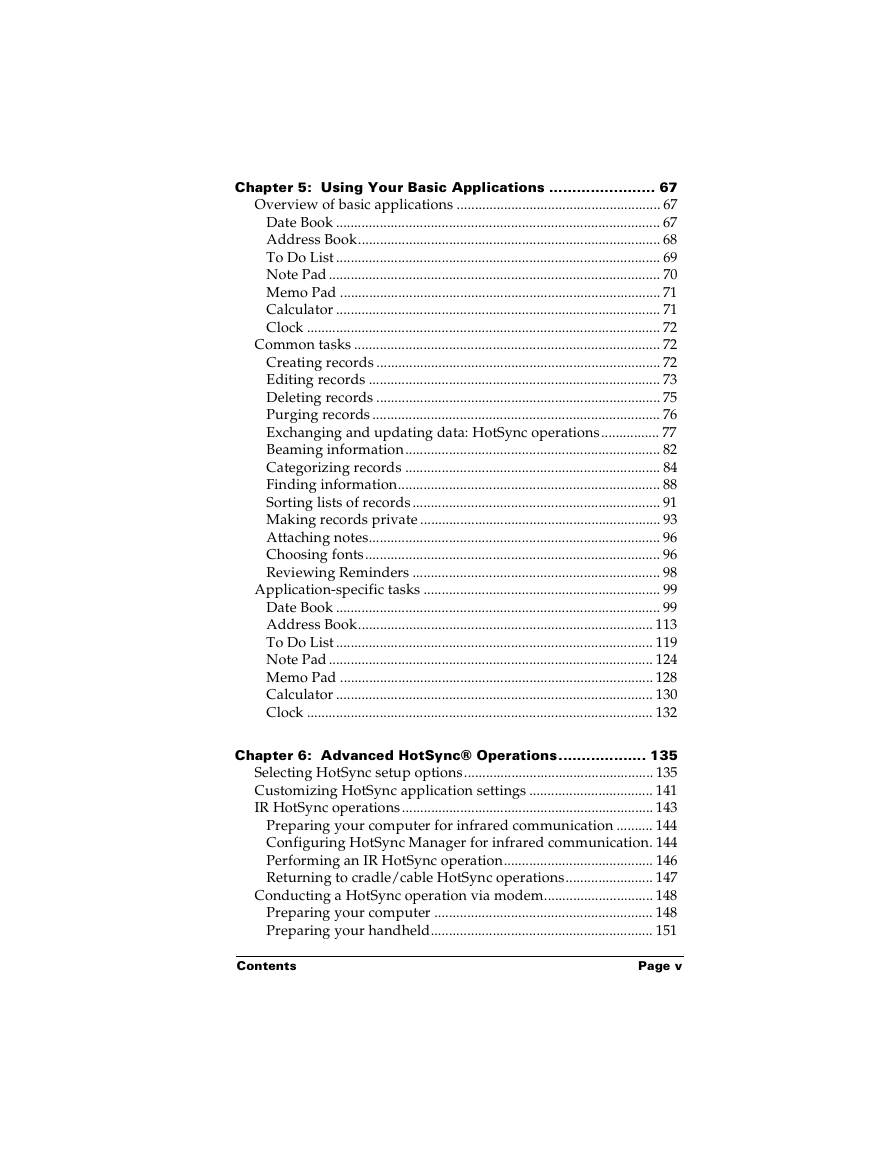

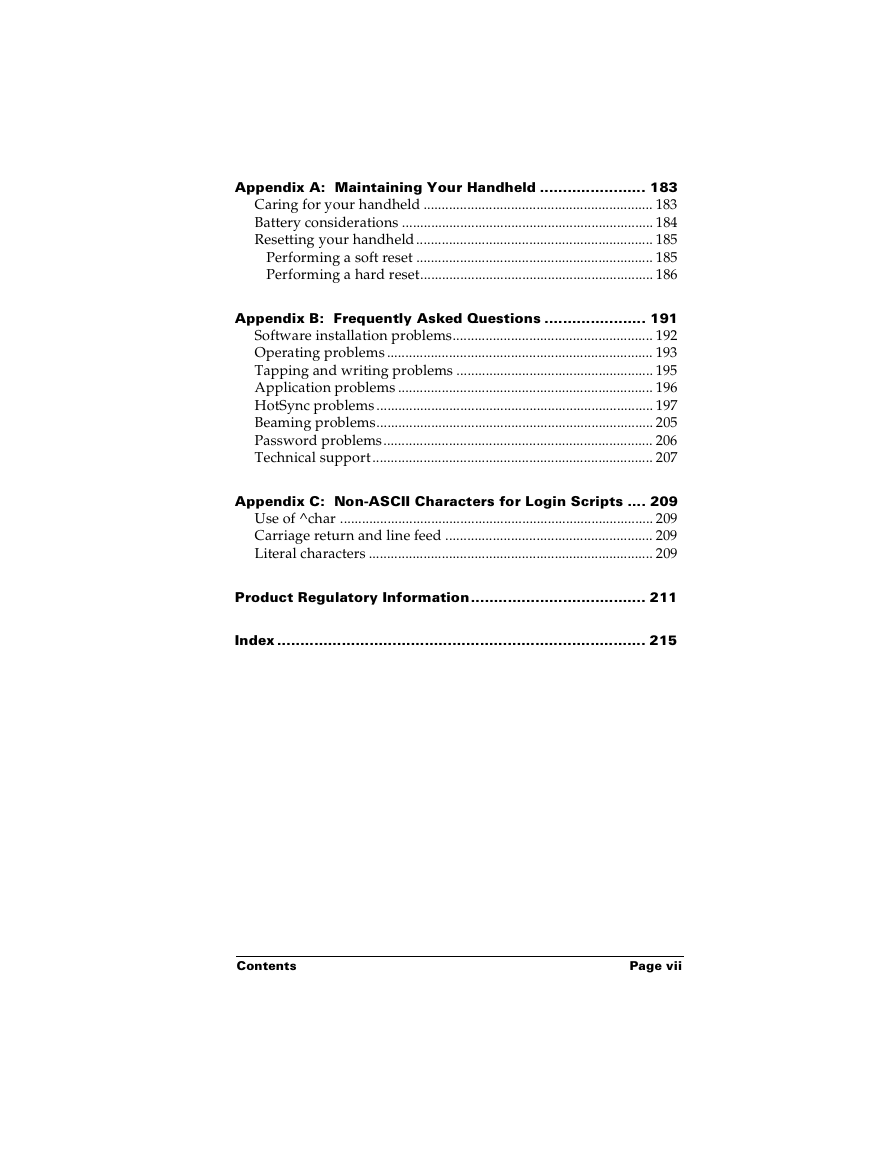









 2023年江西萍乡中考道德与法治真题及答案.doc
2023年江西萍乡中考道德与法治真题及答案.doc 2012年重庆南川中考生物真题及答案.doc
2012年重庆南川中考生物真题及答案.doc 2013年江西师范大学地理学综合及文艺理论基础考研真题.doc
2013年江西师范大学地理学综合及文艺理论基础考研真题.doc 2020年四川甘孜小升初语文真题及答案I卷.doc
2020年四川甘孜小升初语文真题及答案I卷.doc 2020年注册岩土工程师专业基础考试真题及答案.doc
2020年注册岩土工程师专业基础考试真题及答案.doc 2023-2024学年福建省厦门市九年级上学期数学月考试题及答案.doc
2023-2024学年福建省厦门市九年级上学期数学月考试题及答案.doc 2021-2022学年辽宁省沈阳市大东区九年级上学期语文期末试题及答案.doc
2021-2022学年辽宁省沈阳市大东区九年级上学期语文期末试题及答案.doc 2022-2023学年北京东城区初三第一学期物理期末试卷及答案.doc
2022-2023学年北京东城区初三第一学期物理期末试卷及答案.doc 2018上半年江西教师资格初中地理学科知识与教学能力真题及答案.doc
2018上半年江西教师资格初中地理学科知识与教学能力真题及答案.doc 2012年河北国家公务员申论考试真题及答案-省级.doc
2012年河北国家公务员申论考试真题及答案-省级.doc 2020-2021学年江苏省扬州市江都区邵樊片九年级上学期数学第一次质量检测试题及答案.doc
2020-2021学年江苏省扬州市江都区邵樊片九年级上学期数学第一次质量检测试题及答案.doc 2022下半年黑龙江教师资格证中学综合素质真题及答案.doc
2022下半年黑龙江教师资格证中学综合素质真题及答案.doc